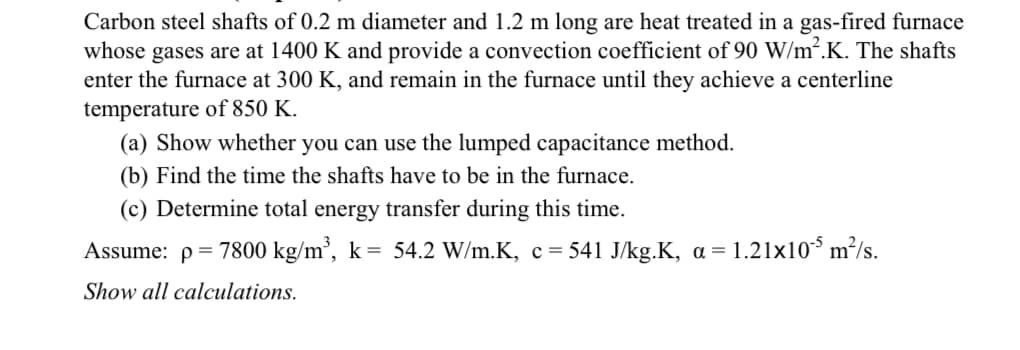Carbon steel shafts of 0.2 m diameter and 1.2 m long are heat treated in a gas-fired furnace whose gases are at 1400 K and provide a convection coefficient of 90 W/m².K. The shafts enter the furnace at 300 K, and remain in the furnace until they achieve a centerline temperature of 850 K. (a) Show whether you can use the lumped capacitance method. (b) Find the time the shafts have to be in the furnace. (c) Determine total energy transfer during this time. Assume: p= 7800 kg/m³, k= 54.2 W/m.K, c= 541 J/kg.K, a = 1.21x10³ m²/s. Show all calculations.
Carbon steel shafts of 0.2 m diameter and 1.2 m long are heat treated in a gas-fired furnace whose gases are at 1400 K and provide a convection coefficient of 90 W/m².K. The shafts enter the furnace at 300 K, and remain in the furnace until they achieve a centerline temperature of 850 K. (a) Show whether you can use the lumped capacitance method. (b) Find the time the shafts have to be in the furnace. (c) Determine total energy transfer during this time. Assume: p= 7800 kg/m³, k= 54.2 W/m.K, c= 541 J/kg.K, a = 1.21x10³ m²/s. Show all calculations.
Principles of Heat Transfer (Activate Learning with these NEW titles from Engineering!)
8th Edition
ISBN:9781305387102
Author:Kreith, Frank; Manglik, Raj M.
Publisher:Kreith, Frank; Manglik, Raj M.
Chapter3: Transient Heat Conduction
Section: Chapter Questions
Problem 3.10P: 3.10 A spherical shell satellite (3-m-OD, 1.25-cm-thick stainless steel walls) re-enters the...
Related questions
Question

Transcribed Image Text:Carbon steel shafts of 0.2 m diameter and 1.2 m long are heat treated in a gas-fired furnace
whose gases are at 1400 K and provide a convection coefficient of 90 W/m².K. The shafts
enter the furnace at 300 K, and remain in the furnace until they achieve a centerline
temperature of 850 K.
(a) Show whether you can use the lumped capacitance method.
(b) Find the time the shafts have to be in the furnace.
(c) Determine total energy transfer during this time.
Assume: p= 7800 kg/m², k= 54.2 W/m.K, c= 541 J/kg.K, a = 1.21x10³ m²/s.
Show all calculations.
Expert Solution
This question has been solved!
Explore an expertly crafted, step-by-step solution for a thorough understanding of key concepts.
This is a popular solution!
Trending now
This is a popular solution!
Step by step
Solved in 3 steps with 2 images

Knowledge Booster
Learn more about
Need a deep-dive on the concept behind this application? Look no further. Learn more about this topic, mechanical-engineering and related others by exploring similar questions and additional content below.Recommended textbooks for you

Principles of Heat Transfer (Activate Learning wi…
Mechanical Engineering
ISBN:
9781305387102
Author:
Kreith, Frank; Manglik, Raj M.
Publisher:
Cengage Learning

Principles of Heat Transfer (Activate Learning wi…
Mechanical Engineering
ISBN:
9781305387102
Author:
Kreith, Frank; Manglik, Raj M.
Publisher:
Cengage Learning